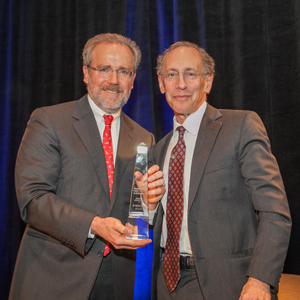Researcher Revolutionized Fight Against Blindness and Cancer
Eye On the Cure Research News
A profile on Dr. Robert Langer, a medical researcher who has received dozens of awards, accolades and honorary degrees, including, recently, FFB’s Visionary Award.

Robert Langer (right) is presented with the Foundation’s Visionary Award by Terry McGuire, co-founder of Polaris Partners.
Dr. Robert Langer's medical technologies may someday reach 2.5 billion people, including those with retinal diseases. That's according to venture capitalist Terry McGuire, who introduced him as a featured speaker at the Symposium on Retinal Innovation recently hosted in Boston by the Foundation Fighting Blindness. The event brought together investors and retinal scientists to discuss potential collaborations and partnerships for advancing retinal-disease treatments.
An M.I.T. Institute Professor, Dr. Langer has founded 20 companies — 18 funded by McGuire's firm, Polaris — and has more than 800 patents issued or pending. He has received dozens of awards, accolades and honorary degrees, including, recently, FFB's Visionary Award.
But early in his career, no one thought his ideas for treating cancer would work. And for a long time, they didn't.
In 1974, Dr. Langer began his post-doctoral work in Dr. Judah Folkman's laboratory in Boston Children's Hospital. Their goal was to develop a treatment to halt the proliferation of blood vessels that enables tumors to grow. Known as angiogenesis, it is the same process that leads to the growth of vision-robbing blood vessels in wet age-related macular degeneration (AMD), which, at that time, inevitably led to catastrophic loss of central vision.
However, Dr. Langer had two big problems: 1) Inhibiting angiogenesis was a controversial approach to treating cancer; and 2) no one believed he could provide sustained delivery of such a treatment to knock tumors out.
Dr. Langer proposed using polymers — a mixture of chemicals acting like a sponge — which could be injected into tumors and provide slow release of anti-angiogenic proteins to stop cancer growth.
"No one had ever developed a polymer system to release these large proteins. The chemical engineering and chemistry communities reported it couldn't be done," Dr. Langer recalled, during the symposium. "My advantage at the time was that I hadn't read any of their research papers."
He experimented — and failed — for several years; "We found 200 ways to not get it to work," he said.
But finally, it did work, though it took Boston Children's Hospital lawyers seven years to patent the technology. "They were ready to give up," recalled Dr. Langer.
Today, angiogenesis-inhibiting drugs are the gold standard for treating wet AMD and many cancers. Dr. Langer's drug delivery systems are also used in pharmaceutical therapies for people with a wide range of conditions, including schizophrenia, diabetes and alcohol and cocaine addiction.
His latest invention is a tiny, drug-releasing microchip that's controlled remotely. It's currently being tested in a clinical trial in Denmark for delivering parathyroid hormone therapy to women with osteoporosis — a treatment that would otherwise be injected.
The Langer Lab at M.I.T. is developing a similar technology for ophthalmic indications. Dr. Langer noted that microchips can also be designed to deliver multiple drugs. "It's like a pharmacy on a chip," he said.
At the end of his presentation at the symposium, someone from the audience asked him how he found the resilience to move beyond his early failures.
"I don't know that I've done anything special. It is easy to talk about it now at this age," said Dr. Langer. "But at the time, I was depressed for several months to see that I wasn't able to get any grants and probably keep my job. I didn't see any alternatives, so I decided to keep my head down and keep plugging away."




